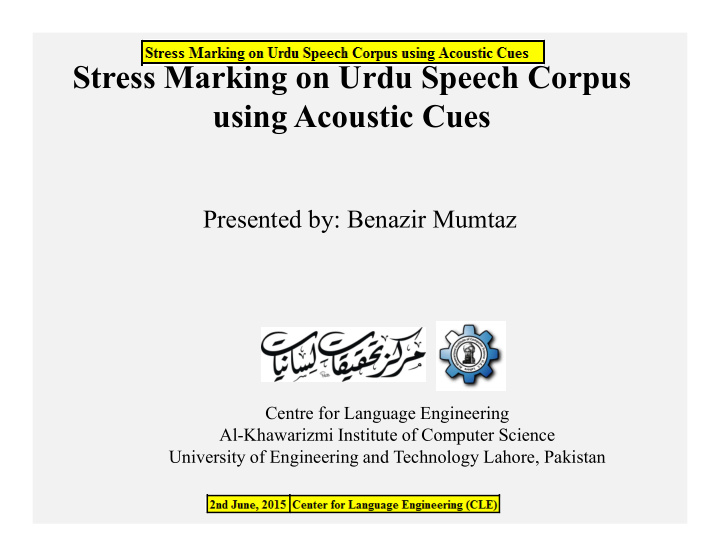



Stress Marking on Urdu Speech Corpus using Acoustic Cues Presented by: Benazir Mumtaz Centre for Language Engineering Al-Khawarizmi Institute of Computer Science University of Engineering and Technology Lahore, Pakistan
Contents • Motivation • Acoustic Impact of Stress • The Process of Annotating Urdu Speech Corpus at Stress Tier • The Process of Assessing Stress Tier Annotation • Results and Discussion
Motivation • To explore the unpredictability of prominence in speech • To explore how stress can change the phonetic properties of a segment • To prioritize the order of acoustic cues for stress marking in Urdu language • To develop an Urdu text-to-speech system
Acoustic Impact of Stress • Duration – Intrinsic duration of the segment [1] – Phonological length [2] – Phrase final syllable [3] • Fundamental frequency/f0 – Intrinsic f0 of the segment – Contextual variation [4] • Intensity – Intrinsic intensity of the segment – Emotional state of the speaker [4]
Description of Urdu Speech Corpus • Speech Corpus Size: 30 minutes • Recording Sampling Rate: 48 kHz • Software: PRAAT
Process of Annotating Urdu Speech Corpus at Stress Tier • While listening to the file for the stress marking, take sub phrases ending in pauses or glottalization • Assign ‘1’ to a stressed syllable and ‘0’ to an unstressed syllable
Prioritized Order of Acoustic Cues for Urdu Stress Marking • Duration of a vowel • Stylized pitch track of a vowel • Phrase initial glottalization • Intensity of a vowel
Duration of a Vowel • Categorize the vowel • Analyze the position of a vowel in a syllable • Comparison with the same shortest vowel – Do not select a vowel which comes at the "final syllable with PAU" position – Short vowel duration = less than 57ms – Long vowel duration = less than 100ms • Comparison with the similar shortest vowel
Durational Analysis of Urdu Vowels Increased Final Final Increased Duration Non- Non- with with Duration Increased at final Final Final Final Final PAU PAU at Duration with VOWEL 0 1 0 1 0 1 Non-final at final pause ə 57 81 61 86 75 107 24 25 32 e: 70 116 81 140 135 188 46 59 53 ɑ̃: 101 155 78 152 148 211 54 74 63 e 57 83 60 96 87 99 26 36 12 əi: NA 134 113 195 201 245 NA 82 44
Pitch Contour • The results indicate that falling or rising slope between L* and H* is abrupt and steep for stressed syllables in Urdu whereas it is gradual and flat for unstressed syllables.
Phrase Initial Glottalization • Phrase initial glottalization – Strong glottalization – Weak glottalization • Phrase final glottalization – Tapering off the vowel
Intensity of a Vowel • It is observed that intensity of an accented syllable in Urdu is on average 3-5dB more than an unaccented syllable. • However, the change in intensity with stress is vowel dependent.
Process of Assessing the Stress Tier • Reference files generation • Testing utilities to ensure that: – All the stress tier labels are from a defined numbering scheme (0, 1) – No interval is left unmarked – No change has been made at the automatically marked syllabification tier while annotating the stressed tier
Discussion • Consonant Lengthening • High intensity of a vowel • Data scarcity issue in the wave file
Future Work • Development of an algorithm • Investigate the unexplored areas i.e., break index, secondary stress, emphatic stress and intonation pattern of Urdu language
Thank You
References 1. Klatt, Dennis H. "Linguistic uses of segmental duration in English: Acoustic and perceptual evidence." The Journal of the Acoustical Society of America 59.5 (1976): 1208-1221. 2. Laeufer, Christiane. "Patterns of voicing-conditioned vowel duration in French and English." Journal of Phonetics 20.4 (1992): 411-440. 3. Berkovits, Rochele. "Utterance-final lengthening and the duration of final-stop closures." Journal of Phonetics (1993). 4. Laukkanen, Anne-Maria, et al. "Physical variations related to stress and emotional state: a preliminary study." Journal of Phonetics 24.3 (1996): 313-335.
Recommend
More recommend